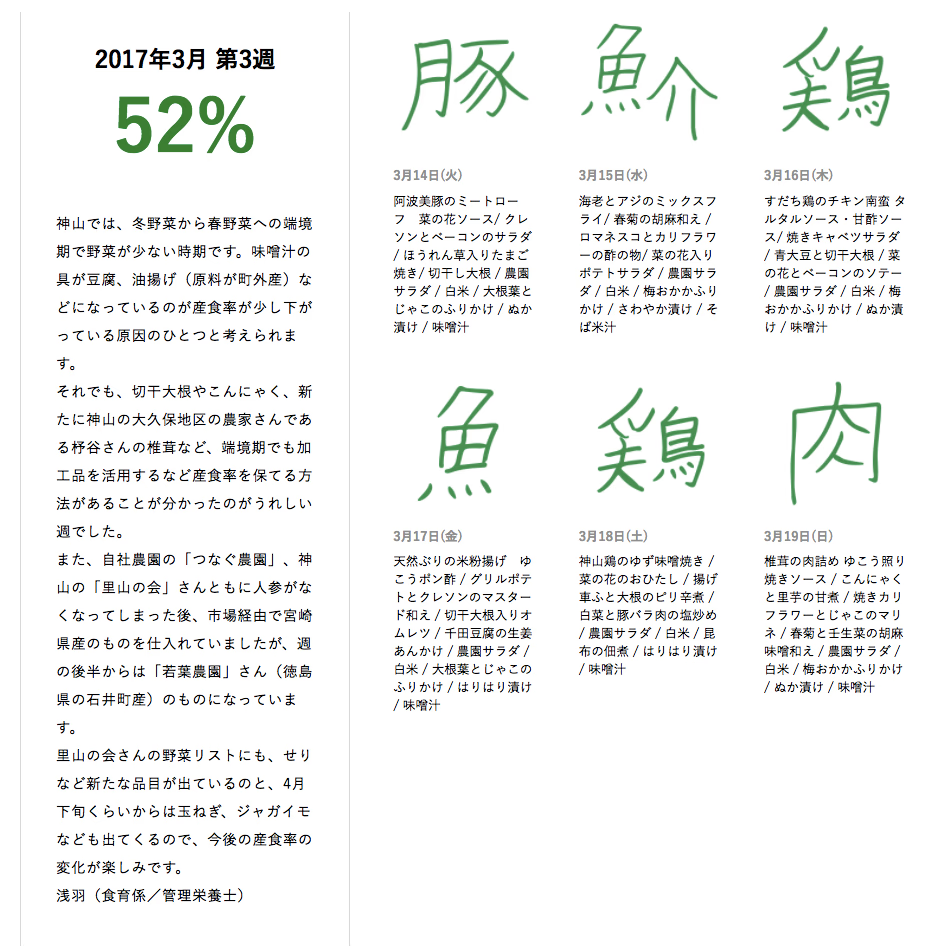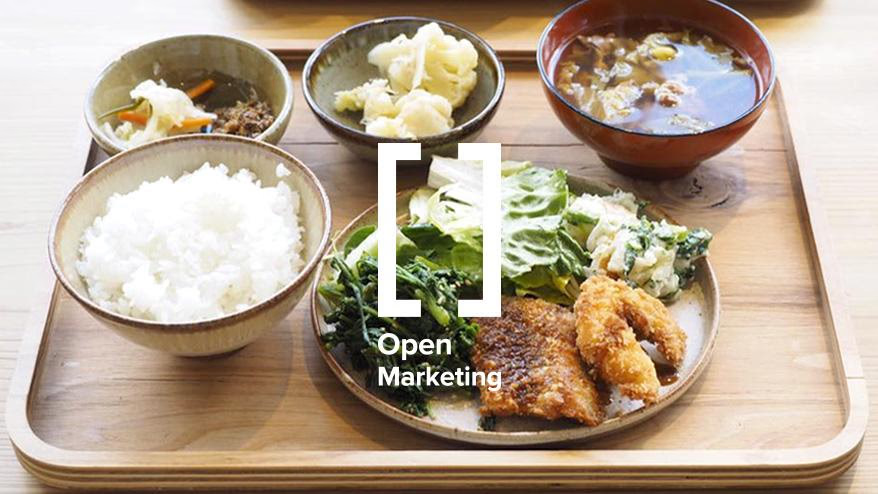みなさん、こんにちは。モノサス代表の林です。
前回からモノサスが徳島県神山町で、神山町役場、神山つなぐ公社と
一緒に立ち上げた、神山の農業を次の世代につなぐための Food Hub Project について
Open Marketing の視点からお話ししています。
前回は、
- 神山が抱える農業および耕作放棄地の課題を
- 神山の人びとが抱える、食についての課題を解決することを通して解決する
ということをお伝えしました。
今回は、具体的にどのようにして課題を共有していこうとしているかについて
お話したいと思います。
課題を共有するための共通の指標をもつ。
Food Hub Project が掲げている指標のひとつに
「産食率」というものがあります。
これは地産地食率を省略したもので、
フードハブの食堂「かま屋」で使用している食材の
どれくらいの割合が神山産で賄われているかを数値化したものです。
国が算出している食料自給率のように、カロリーや生産額を元にする算出方法ではなく、
学校給食などでも用いられている
「食材品目数(町内産)÷ 食材品目数(総合計)」
という方法で算出しています。
カロリーや、生産額をもちいたほうが
一見より有効な産食率が算出できるように思われるかもしれませんが
- 米や野菜をすでに自社農園で生産しているので、カロリーベースでは比較的高い数値が出やすい
- 自社農園産のものと、仕入れたものとを、単純に生産額で比較することは難しい
- 相対的にカロリーの低い食材(野菜や調味料、豆腐、こんにゃく)などもきちんとカウントしてゆきたい
といった理由から、食材の品目数で産食率を算出することにしています。
また、Food Hub Project ではこの数値を週ごとにWebサイトで公表しています。

この産食率は Food Hub Project の活動の根幹といってもよい指標であり、
この数値を共有し、改善してゆくことが神山の人びととの
課題の共同解決でもあると考えています。
公開しているのは産食率というひとつの指数にすぎませんが、
この取り組みには Food Hub Project のさまざまな想いが込められています。
Open MarketingのVol.11でもお伝えしたように、
約100年前に誕生し、発展してきたマーケティング手法には
いくつかの問題があります。
それは
- 少量生産少量消費から大量生産大量消費に移行したことで双方がアノニマスな存在になってしまった
- それに伴い、情報の非対称性が発生し、それを利用してマーケティングが行われてきた
という点です。
近年のインターネットの匿名掲示板等で交わされる言葉でもおわかりのように、
お互いが匿名である場合、残念ながら多くの人は、心無い言動をする傾向があります。
それらを解決するために企業はブランディングという取り組みを通して
自らの匿名性を和らげる努力をしてきました。
しかし、このブランディングも
顧客側はアノニマスであることを忘れてはなりません。
ブランディングとは、ある意味では
実態のない虚構ともいえる「消費者」という存在に向かって
「自分たちは正しく企業活動をしています」という、
解のない一方通行の活動とも言えるのではないでしょうか。
また、これまでのマーケティングでは、
多くの企業が情報の非対称性を利用してきました。
これは流通の仕組み上、しかたのない部分もあります。
生産活動と消費活動をする場が、離れてしまったうえに
生産活動そのものが工業化などによって複雑になってしまったからです。
特定多数に対して、オープンに活動をする。
それに対して Food Hub Project では、ふたつのことを
大切にして活動をしています。
それは
- 神山に関わりのある特定多数の人びとを対象とし、双方の顔が見える関係性を大切にする
- 自分たちの考え、取り組みをオープンにし、情報の非対称性をできる限り排除する
ことです。
Food Hub Project では、
農園で農産物を生産するつくり手、食堂で料理をするつくり手、
パン工房でパンをつくるつくり手、すべてのつくり手が顔を出し、
お店を訪れていただいた人びとが、すべての生産活動を見ることが
できるようになっています。
さらに、自分たちの活動をただ見える状態にするだけでなく、
神山の人びとと共有し、本当の意味で活動をオープンにするための指標が
産食率なのです。
産食率を向上させるために一番重要なことは、
神山の人びとが Food Hub Project が運営するお店を訪れ、
神山の食材でつくられた料理を食べたり、食材を買って帰って料理をしてくれることです。
そうすることで、神山内で作られる農産物、それらの加工品の
量やバラエティ、そして質が向上し、
耕作放棄地が耕作地に変わり、神山の食もより豊かになってゆくのです。
Food Hub Project 内の指標から町内の指標へ
現在この産食率という指標は、Food Hub Project の、「かま屋」という
食堂内の比率でしかありません。
町内全体の産食率の算出のためには膨大なデータを根気よく集める必要が
あるため、現在はまだそこに手をつけられていないのが正直なところです。
ですが、5年〜10年以内には Food Hub Project 内のみならず神山町内の
産食率も算出し、共有したいと考えています。
そうすることが、本来の Food Hub Project の目的でもあり、
また、顧客とともに社会課題の解決を目指すという
Open Marketing の趣旨とも一致してゆくからです。
前回から2回にわたって、Food Hub Project での私たちの取り組みを紹介しながら
顧客の課題を解決することを通して、社会課題を解決する仕組みを構築する
ということの具体例をお伝えしました。
今回はここまでにしたいと思います。
今月も最後までお読みいただきありがとうございます。
※P.S.
Food Hub Project が運営する、食堂「かま屋」と、「かまパン&ストア」が
3月3日に無事オープンしました。
連日たくさんのお客さまにお越しいただき、大変ありがたく思っております。
この記事をお読みの皆さまも、もしお近くにお越しの際は、ぜひぜひ一度
お立ち寄りください。

